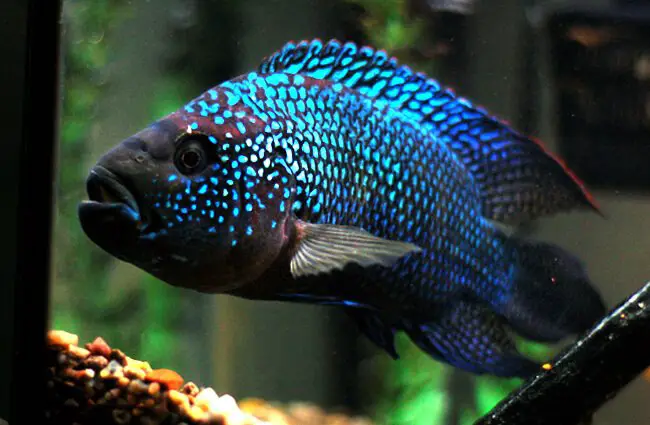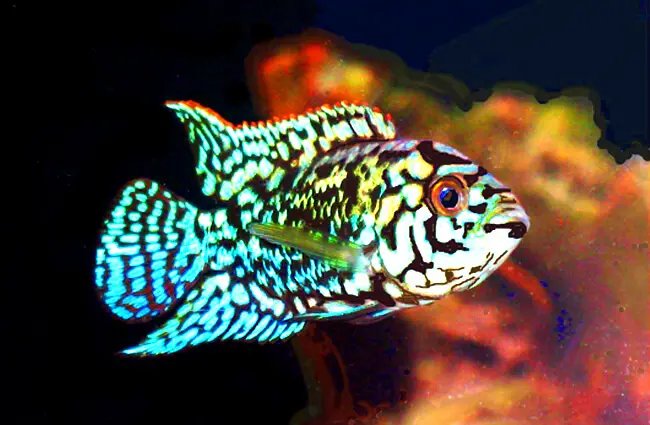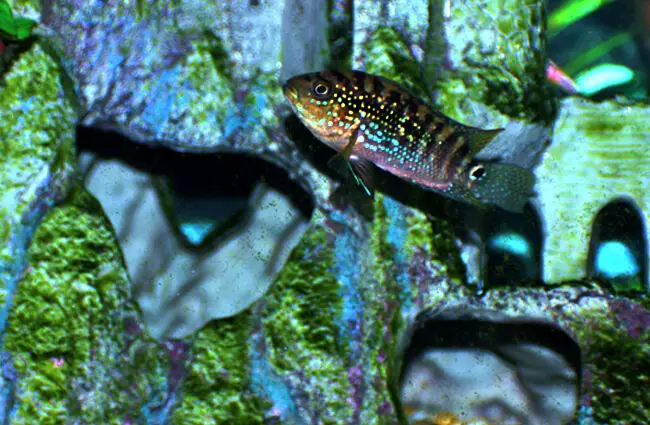Meet the Jack Dempsey: A Comprehensive Guide to this Striking Cichlid
The Jack Dempsey cichlid, Heterochromis ventris, is a freshwater fish renowned for its bold personality, vibrant colors, and impressive size. Native to Central America, this fish has captivated aquarists and researchers alike. Often called the “Mexican Jewel” or simply “Jack Dempsey,” it is a truly remarkable species deserving of a closer look.

Origins and Habitat
Jack Dempseys originate from the slow-moving rivers, canals, and swamps of southern Mexico, Guatemala, and Honduras. They prefer warm, slightly acidic to neutral water and environments with plenty of vegetation and structures such as submerged logs or roots. These provide shelter, breeding sites, and territories. In the wild, they inhabit areas rich in organic matter and exhibit a remarkable tolerance for varying water conditions. Understanding their natural habitat is crucial for providing appropriate care in captivity. They are often found coexisting with other cichlids and various species of tetras and catfish.
Physical Characteristics
Adult Jack Dempseys typically reach a length of 6 to 8 inches, though some individuals can grow even larger. Their bodies are laterally compressed, meaning they are relatively flat from side to side. They exhibit a distinct nuchal hump, a fleshy bump on the forehead, which becomes more prominent as they mature, particularly in males. Coloration is variable, ranging from silver and gray to vibrant shades of blue, green, and even red, depending on mood, environment, and genetic factors. Dark vertical bars are often present, and they can develop striking patterns during breeding. Fish possess a robust jaw and sharp teeth, reflecting their predatory nature.

Diet and Feeding Behavior
Jack Dempseys are opportunistic omnivores, meaning they will consume a wide variety of food. In the wild, their diet consists of insects, crustaceans, small fish, worms, and plant matter. In captivity, they thrive on a balanced diet of high-quality cichlid pellets, supplemented with live or frozen foods such as bloodworms, brine shrimp, and daphnia. They are active hunters and will readily pursue and consume prey. They exhibit a strong preference for meaty foods, and providing a varied diet is essential for maintaining their health and vibrant coloration.
Reproduction and Life Cycle
Jack Dempseys are substrate spawners, meaning they lay their eggs on a flat surface. The breeding process typically begins with a courtship display, where the male attempts to impress the female with his vibrant colors and vigorous movements. Once a suitable spawning site is selected, the female will lay a cluster of eggs, which the male then fertilizes. Both parents actively guard and fan the eggs, removing any debris or dead eggs. The eggs usually hatch within 2 to 3 days, and the fry are initially quite small and vulnerable. The parents continue to protect and feed the fry for several weeks, providing them with tiny food particles. Young Jack Dempseys reach sexual maturity around 6 to 12 months of age.

Ecological Role and Interactions
In their native habitats, Jack Dempseys play an important role in regulating populations of smaller fish and invertebrates. As key predators, they help maintain the balance of the ecosystem. They also contribute to nutrient cycling through their feeding habits and waste products. Jack Dempseys often compete with other cichlid species for territory and resources. They may also be preyed upon by larger fish or birds, although this is relatively uncommon. They are known to be territorial, especially during breeding season, and will vigorously defend their chosen spawning site from intruders.
Jack Dempseys and Humans
Jack Dempseys have become popular aquarium fish due to their striking appearance and moderate care requirements. They are often kept as centerpiece fish in larger tanks, where they can showcase their vibrant colors and bold personality. However, their territorial nature means they should not be kept with overly peaceful or small fish, as they may be bullied or harassed. They are also known to rearrange the substrate and uproot plants, so a well-decorated and sturdy tank is essential. In some regions, they are also raised for food, although this is not common.

Interesting Facts
- Jack Dempseys are named after the famous boxer Jack Dempsey, due to their aggressive and tenacious nature.
- They can change color depending on their mood and environment.
- They are known to exhibit parental care, actively guarding and protecting their eggs and fry.
- They can live for 8 to 10 years in captivity with proper care.
- They are relatively intelligent fish, capable of recognizing their owners and responding to stimuli.
- The nuchal hump is more prominent in males and becomes more pronounced as they mature.
Encountering a Jack Dempsey in the Wild
If you are traveling in the regions where Jack Dempseys are native, you may encounter them in slow-moving rivers, canals, or swamps. It is best to observe them from a distance and avoid disturbing their natural habitat. Do not attempt to handle or capture them, as they may bite. If you are bitten, clean the wound thoroughly with soap and water.

Caring for Jack Dempseys in Captivity: A Zookeeper’s Perspective
Maintaining Jack Dempseys in captivity requires careful attention to their specific needs. A tank of at least 75 gallons is recommended for a single adult, with more space provided for multiple individuals. A robust filtration system is essential to maintain water quality. Regular water changes should be performed to remove accumulated waste. A varied diet, consisting of high-quality cichlid pellets, live, and frozen foods, should be provided. The tank should be decorated with sturdy rocks, driftwood, and plants that can withstand their tendency to rearrange the environment. Regular health checks should be performed to monitor for signs of disease or injury. It’s vital to avoid overcrowding, as this can lead to stress and aggression.

Conclusion
The Jack Dempsey cichlid is a truly remarkable fish, captivating aquarists and researchers alike. Its striking appearance, bold personality, and unique behaviors make it a fascinating subject of study. Understanding their natural history, habitat, and care requirements is crucial for ensuring their well-being in captivity. Whether you are an experienced aquarist or simply an animal enthusiast, the Jack Dempsey is sure to leave a lasting impression.

![Red Angus Closeup of a beautiful Red Angus cowPhoto by: U.S. Department of Agriculture [pubic domain]https://creativecommons.org/licenses/by/2.0/](https://animals.net/wp-content/uploads/2020/03/Red-Angus-4-238x178.jpg)




![Red Angus Closeup of a beautiful Red Angus cowPhoto by: U.S. Department of Agriculture [pubic domain]https://creativecommons.org/licenses/by/2.0/](https://animals.net/wp-content/uploads/2020/03/Red-Angus-4-100x75.jpg)

